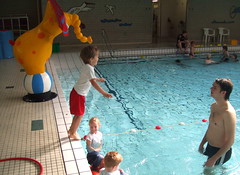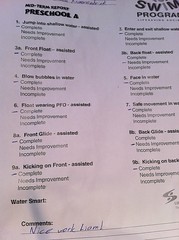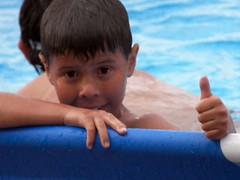Ears in the Water: Assessment for Improvement
Manage episode 157115785 series 1210809
Click here to listen to a dramatic reading of this post by the author. | Want to subscribe?
Lately, I’ve been thinking about the impact of assessments that are based on criteria versus percentiles and norms. My thoughts about how all assessments don’t equally help students improve were kick started with smell of chlorine, beside the flutter boards at the local community pool.
The din of mothers with their babies and preschoolers splashing in the pool accent most Saturday mornings at the local pool. Mothers and tots are led through actions and an awkward singing of such classics as ‘The Wheels on the Bus’ and ‘Row Row Row Your Boat’. During these mornings you will find me sitting against a wall near the shallow end, with a towel on my lap, watching my four year old learning to swim.
 There are several parents, each living vicariously through the 5 little guys kicking, jumping, and splashing in front of us. I know it is silly, but each time my son is asked to do a front glide or a back float with the teacher my attention builds and I mentally ‘will’ him to do well. Each kick and turn leads me to hope that he will have improved since the last lesson. The parents act like a support group. Red faces are evident when their child refuses to attempt something and each person has uttered the phrase, ‘it is weird, he loves the water when we are at free swim’. After we all look away for the requisite moment, we murmur ‘it’s OK’ and ‘it gets better’ to the parent. And when the teenage instructor handed my child a piece of paper that had water drops and smudges by the time it arrived on my lap, it only took a second to realize what it was. My son had just received his first report card, although this was his mid-term swimming report.
There are several parents, each living vicariously through the 5 little guys kicking, jumping, and splashing in front of us. I know it is silly, but each time my son is asked to do a front glide or a back float with the teacher my attention builds and I mentally ‘will’ him to do well. Each kick and turn leads me to hope that he will have improved since the last lesson. The parents act like a support group. Red faces are evident when their child refuses to attempt something and each person has uttered the phrase, ‘it is weird, he loves the water when we are at free swim’. After we all look away for the requisite moment, we murmur ‘it’s OK’ and ‘it gets better’ to the parent. And when the teenage instructor handed my child a piece of paper that had water drops and smudges by the time it arrived on my lap, it only took a second to realize what it was. My son had just received his first report card, although this was his mid-term swimming report.
The mid-term report card had about 20 different items listed and each was rated as complete, needs improvement, or incomplete. I pretended not to care. I tried not to look at it, you know it isn’t that big of deal.
What if the report had stated that Liam, my son, was in the 60th percentile of swimming proficiency for children his age? How would I know how he could improve? How would he know how to improve? I’m not sure the bell curve would have helped Liam.
Instead the report focused on specific skills that needed to be improved. These were combined with what feedback the teacher gave to Liam during class to develop the criteria that will help him become a better swimmer. It could have been said that he has a few areas to improve. But he was told he needed to improve on his back float and back glide. This was combined with what I’d overheard to be: Liam on your back float and glide, you need your ears in the water, your chin up, and your chest up.
Guess what? The next week, for the first time this course when he tried the back float, his ears were in the water. The teacher then just asked him to put his chin up and chest up. Which he quickly remembered and did. As he splashed back to the side of the pool, his eyes searched for mine. He pointed to his ears while his teeth were exposed with a large grin as water dripped down his face.
 I was reminded that when reporting student achievement to parents, ranking isn’t as hopeful or productive as criteria. With criteria we can improve, we can make a difference. Clear criteria as someone learns starts a conversation. A conversation that that person has internally as they attempt to apply their learning and is followed up with people around them.
I was reminded that when reporting student achievement to parents, ranking isn’t as hopeful or productive as criteria. With criteria we can improve, we can make a difference. Clear criteria as someone learns starts a conversation. A conversation that that person has internally as they attempt to apply their learning and is followed up with people around them.
Liam knew what he needed to do to improve in the moment. He wasn’t perfect, but he was improving by applying the criteria. Is that a key principal for learning? Understanding the criteria that will help us improve? If the teacher and the learner don’t know the criteria, how can we learn?
 Liam doesn’t care what percentile he is in, but his smile showed a deep self satisfaction with his improvement. His smile was met with a thumbs up from me.
Liam doesn’t care what percentile he is in, but his smile showed a deep self satisfaction with his improvement. His smile was met with a thumbs up from me.
Ears in the water, check.
—-
Photo Credits:
2 episoder




